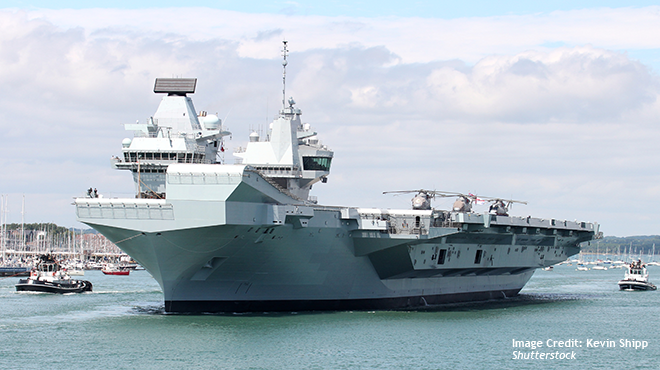London Increases its Naval Presence in the Pacific

London increases its naval presence in the Pacific.
Those who control the seas have always been able to influence the world and manage to protect their investments and interests abroad. The United Kingdom is unlikely to reach its former levels of naval superiority on the seas. However, the introduction of the aircraft carriers HMS Queen Elizabeth and HMS Prince of Wales to the Royal Navy’s fleet is a symbol of the renewed importance of the maritime space, London’s foreign policy aspirations and British power projection capabilities.
HMS Queen Elizabeth the new Flagship and leader of the Carrier Strike Group
On the 27th of January 2021, the HMS Queen Elizabeth formally took over the position of Fleet Flagship of the Royal Navy from the HMS Albion. The HMS Queen Elizabeth weighs in at 65,000 tons, with a total length of 280 meters and the capacity to carry up to 40 aircraft. She is the largest and most advanced vessel ever deployed by the Royal Navy. HMS Queen Elizabeth will set out for Japan on her maiden voyage during the spring of 2021. Once in Japan, she will participate in wargames together with the Japanese Maritime Self-Defence Force around the Nansei island group.
During her maiden voyage, the HMS Queen Elizabeth will be at the heart of the Carrier Strike Group (CSG21), where the RFA Fort Victoria will join her as a solid support ship, as will two type 45 destroyers (HMS Diamond and HMS Defender), two type 23 frigates (HMS Northumberland and HMS Kent) as escort and protection, one Tide-class tanker, and one nuclear submarine. The CSG21 achieved Initial Operating Capability (IOC) on the 4th of January 2021 after successfully participating in the Joint Warrior NATO exercise in October 2020. Full Operating Capability is expected to be reached by 2023, mainly pending the timely delivery of more F-35B jets. On her maiden voyage, she will carry a total of 24 F-35B jets, supplied by both the UK and the US and manned by personnel from both countries. There is a long and very close history of cooperation between the Royal Navy/the Royal Marines and their American sister services. The CSG21-arrangement is further improving this cooperation and the ability to conduct effective combined operations.
A maiden voyage with dual purposes
The HMS Queen Elizabeth will first participate in the spring Joint Warrior Exercises during 2-13 May 2021, after which she will set out on her maiden voyage. The details of the journey are still to be announced, but a general route via the Mediterranean, the Middle East, and the Pacific has been confirmed. Throughout this itinerary, the CSG21 is likely to make stops in harbors of political and military importance, and most likely some of which previously constituted strongholds during the imperial era, such as Singapore. The HMS Queen Elizabeth is also likely to receive further escort and protection beyond that provided by the CSG21 ships from allies along the way. Currently, the United States and the Netherlands are the countries with the most advanced plans for cooperation, but other allies such as Norway and Denmark have also expressed interest in joining. If and how different EU countries choose to participate in the deployment may be an indicator of the attractiveness of London as a security and defense partner, post-Brexit. For the European Union and for the UK, it is vital to maintain a close partnership in security and defense even after Brexit.
Pacific presence and potential Chinese retribution
According to Prime Minister Boris Johnson, the aim of the deployment is to have “naval assets in the world’s most important regions, protecting the shipping lanes that supply our nation”. The deployment is aimed at boosting morale within the Royal Navy and sending a signal to allies and adversaries alike that the United Kingdom is taking back some “rule over the seas”. However, with the Royal Navy’s capacities still being too sparse to have a permanent presence in the Pacific, some critics worry that the choice of Japan as the first destination might be an unnecessary provocation against China, without any long-term benefits for the Pacific region or the United Kingdom. Some concerns have also been voiced about possible political or economic retribution from Beijing. Furthermore, depending on the more detailed activities the CSG21 will be engaged in, the risk of direct confrontations with PLA Navy ships and aircraft should not be underestimated.
Critics have argued that the development of the two carriers is not in the best interest of UK defense policy and capability building, and that the cost to build and operate the two ships and the strike groups is too high for the UK defense budget. For the Royal Navy, a successful operation with HMS Queen Elisabeth and the entire carrier strike group is there for hugely important.